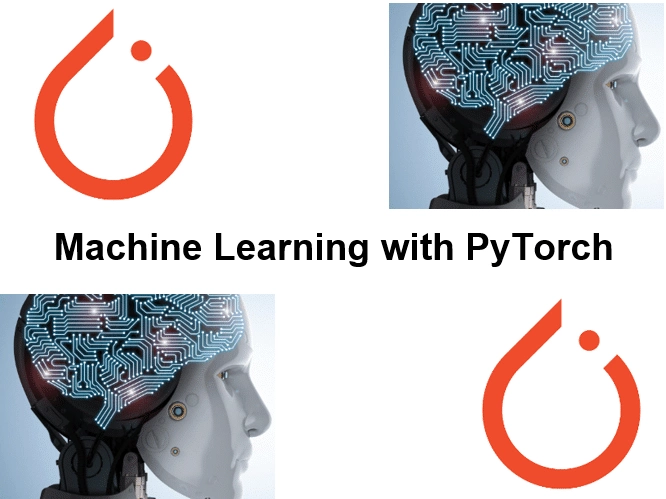-
Learning by doing
-
Trainers with practical experience
-
Classroom training
-
Detailed course material
-
Clear content description
-
Tailormade content possible
-
Training that proceeds
-
Small groups
In the course Machine Learning with PyTorch from SpiralTrain data scientists, data engineers and aspiring machine learning practitioners learn how to harness the power of the PyTorch framework to create machine learning applications using Python and the Torch library. The course covers fundamental concepts and advanced techniques and provides a hands-on learning experience in the exciting field of machine learning.
The course Machine Learning with PyTorch starts with an introduction to PyTorch, covering the basic principles of tensors, autograd and the PyTorch ecosystem.
Subsequently linear regression in PyTorch for predicting results is discussed, including optimization with gradient descent, loss functions, regularization techniques and evaluation metrics.
Then neural networks with PyTorch are treated, where activation functions, backpropagation and optimization algorithms are explained.
Classification tasks in PyTorch are also covered with logistic regression and cross entropy losses. Both binary and multi-class classification are treated.
And model building is also on the program of the course Machine Learning with PyTorch. Here it is explained how more complex models can be based on fundamental building blocks, using feature engineering, categorical variables and hyperparameter tuning.
Then Natural Language Processing with PyTorch is explained. The use of text classification, named entity recognition and sequence to sequence models for machine translations is covered.
And reinforcement learning with PyTorch is also on the program. Among others, Markov Decision Processes, Q-Learning, Policy Gradients and Actor-Critic Methods are discussed then.
The use of PyTorch for image processing is also covered, including classification, object detection and semantic segmentation.
Finally attention is paid to optimizing machine learning models in PyTorch with the goal to improve performance and efficiency. Techniques such as batch normalization, hyperparameter tuning and pruning are treated then.
The course Machine Learning with PyTorch is intended for data scientists who want to use Python and the Torch machine learning library to create models and make predictions.
To participate in this course, knowledge of and experience with Python is required and knowledge of data analysis libraries such as Numpy and Pandas is desirable.
The theory is discussed through presentations. Illustrative demos clarify the concepts. The theory is interchanged with exercises.
After successfully completing the course, attendants will receive a certificate of participation in Machine Learning with PyTorch.

Module 1 : Intro PyTorch |
Module 2 : Linear Regression |
Module 3 : Neural Networks |
|
Machine Learning Intro Overview of PyTorch Installing Anaconda Setting Up PyTorch PyTorch Tensors Tensor Operations Simple Neural Networks Datasets and DataLoaders Fundamentals of Autograd Model Evaluation Metrics |
Linear Regression in PyTorch Gradient Descent Optimization Mean Squared Error Regularization Techniques Feature Scaling Feature Normalization Categorical Features Model Evaluation Metrics RMSE, MAE, R-squared Hyperparameter Tuning |
Neural Networks Intro Building NN with PyTorch Multiple Layers of Arrays Convolutional Neural Networks Activation Functions Loss Functions Backpropagation Gradient Descent Stochastic Gradient Descent Recurrent Neural Networks |
Module 4 : Classification |
Module 5 : Model Building |
Module 6 : Natural Language Processing |
|
Logistic Regression Binary Classification Multi-class Classification Cross-Entropy Confusion Matrix Precision and Recall ROC Curve Handling Imbalanced Data Regularization Techniques Hyperparameter Tuning |
PyTorch Models Model Components Parameters Common Layer Types Linear Layers Convolutional Layers Input Channels Recurrent Layers Transformers Data Manipulation Layers |
NLP Overview Text Preprocessing Tokenization Stopword Removal Spam Detection Bag-of-Words Word Embedding Sentiment Analysis Attention Mechanisms Transformer Models |
Module 7 : Reinforcement Learning |
Module 8 : Image Processing |
Module 9 : Model Optimization |
|
Intro Reinforcement Learning Markov Decision Processes Q-Learning Deep Q-Networks Policy Gradient Methods Actor-Critic Methods Proximal Policy Optimization Deep Policy Gradient |
Image Preprocessing Resizing and Normalization Convolution Layer Convolutional Neural Networks Object Detection Transfer Learning Semantic Segmentation Image Captioning |
Profiling PyTorch Profiler With TensorBoard Hyperparameter tuning Parametrizations Pruning torch.compile Dynamic Quantization High-Performance Transformers |
